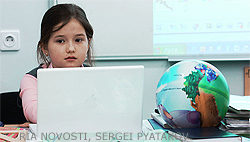Teachers Reveling in Growing Technology

Lena Smirnova – Moscow Times – themoscowtimes.com – October 5, 2012
Thousands of kilometers from the capital, a lone interactive whiteboard sits in a customs warehouse on Russia’s southern border.
The device’s Turkish manufacturer, Vestel, is rushing to get the unit to its Moscow showroom and start selling the product to schools. But more than two months is expected to pass before that happens and Vestel can join other companies cashing in on supplying classrooms with the newest education technology.
Russian schools have become the prime destination for educational technologies such as interactive boards, learner response remotes and audio systems, thanks to a state initiative to increase the amount of such devices in schools and a growing interest from teachers.
The best news for companies is that the market is still wide open. Only 16.4 percent of Russian classrooms are equipped with interactive boards, while in Britain this number has reached 75 percent, said Eugene Viscovic, president of the international markets department at Promethean, which has supplied 8,700 interactive systems to Moscow schools alone.
“For the UK to be today at 75 percent classroom penetration with this technology, it took 10 years, which means for Russia it’s going to take a long time to have every classroom equipped,” Viscovic said. “But you need to start somewhere.”
Companies that supply technology for educational institutions in Russia got a stimulus in 2011 when then-Prime Minister Vladimir Putin issued an order to modernize secondary schools by equipping them with more computers and other technologies. In 2011, 6,700 schools across the country were slated to receive new equipment.
“Now there is no going back,” said Svetlana Titova, vice dean at Moscow State University’s Department of Foreign Languages and Area Studies. “There are new standards, so whether the teachers want to or not, they have to study and move forward.”
Yelena Novikova saw an interactive board for the first time at an exhibit in 1993. Five years later, as the general director of Polymedia, she brought the first such board to a Russian classroom. Her company recently partnered with Promethean and has high hopes for the local market.
“This is no limit,” Novikova said. “There is room to grow. Russia has about 50,000 schools and 700,000 audience members. In Moscow today, every other [school] has an interactive board, and in Russia, it’s one in five.”
Other companies are also rushing to sell new technologies to Russian schools.
Panasonic has equipped 11,000 classrooms in Russia with interactive boards since it started addressing this market segment four years ago, said Irina Smirnova, coordinator of education programs at Panasonic. The company also recently started selling sound systems that facilitate the use of more audio materials during lessons.
New entrant Vestel is No. 1 in its home market of Turkey, where it sold 85,000 digital boards to schools this year, and it is now hoping to replicate this success in Russia. The company expects the first interactive board to arrive at its showroom in November, said Kivanc Isik, general director of the company’s Russia office.
The price of the technology used to be a significant barrier, Smirnova said, but things have picked up since the federal program made equipping schools a priority. Companies can look for opportunities on Russia’s official site for state orders, where municipal education departments post tenders for supplying their schools with computers or digital whiteboards.
Tsaritsyno Moscow High School No. 548 is one of the city’s most progressive schools in terms of its technology arsenal. The school’s administration started thinking about technology supplies in the 1990s and got the first interactive board in 2000. Now, the school has more than 800 computers and 50 interactive boards for its 2,300 students.
The trick is not to depend only on government support but find business-led competitions where teachers can win this technology, said Elena Shimutina, deputy director for information technology at the school. Shimutina added that part of her job is to find such competitions and notify teachers.
“There are different paths to getting this technology,” Shimutina said. “Sometimes you have to pay, and sometimes you just win competitions from companies.”
Even the more modest schools in Moscow are fairly well-supplied with technology, experts said. Schools in the regions are also doing well.
Panasonic has supplied its technologies to almost every region in Russia, Smirnova said. Large orders for interactive boards have come from Vladivostok, the Volga and Northwestern federal districts, the Krasnodar region and Chechnya.
The main problem now is that classroom technology is frequently underused.
“They have the technology, but they don’t know how to use it,” Titova said.
Titova teaches the online professional development courses for high school teachers and institute professors that are offered through Moscow State University. About 200 schoolteachers take these courses each year, she said.
Some companies also offer teachers training in using their technologies.
Polymedia issues brochures and DVD courses to teachers. Panasonic has independently trained 4,000 teachers, but it now directs teachers to professional development centers because the undertaking was too large, Smirnova said.
Shimutina has seen interactive boards used simply as projectors, with much of their functionality ignored, and she said that cases like these are shifting the discussions about the technology.
“Now we are talking more about the quality of teaching that is offered through technology,” she said.” We have started to look deeper into how we use this technology instead of just saying ‘give us more, give us more, give us more’.”
